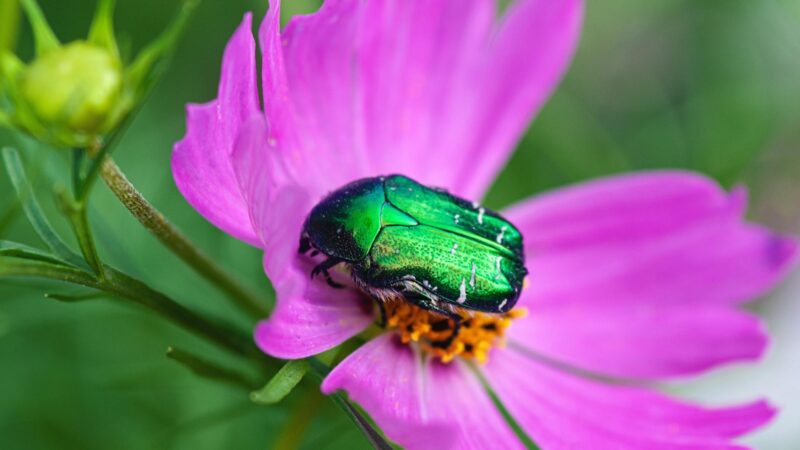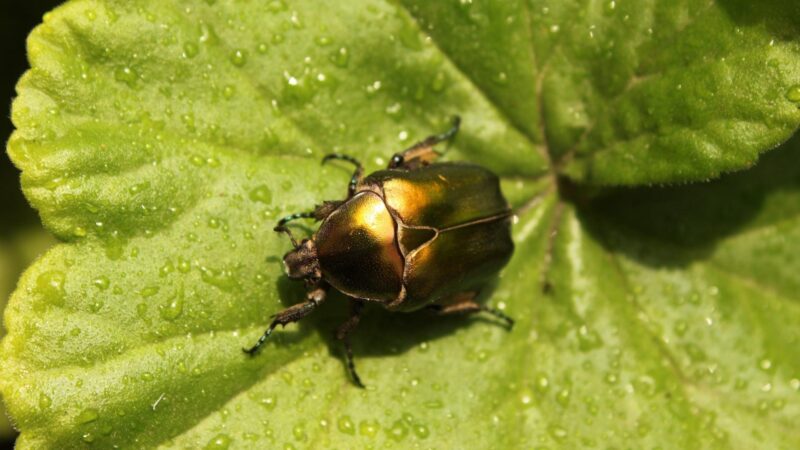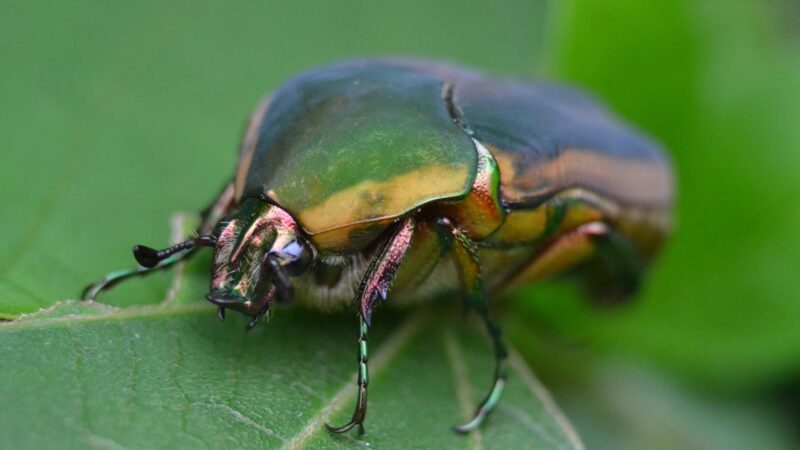June bugs are some amazing creatures. They buzz, dart, and fly around. If you are the type of person who has a lot of questions, then you might be wondering if June bugs bite.
They don’t bite and are generally harmless. They are not a species of insect that bites or stings. June bugs are known for their ability to live in large groups and swarm over a wide area, but they do not bite or attack people.
As June bugs are typically harmless, they are commonly found in gardens, fields, and other areas. They like to feast on plant leaves and flowers.
Table of Contents
What Is a June Bug? What Do They Look Like?

June bugs, also called June beetles, are small, black insects that are known for their shiny, reflective wings. They have a metallic shine to their wings and legs, giving them a unique quality.
It makes them easy to spot in the summer months when they’re most active. They have three pairs of wings and two antennae.
The three pairs of wings are called elytra; the two larger ones (the second pair) are called dorsal wings, while the smaller pair is ventral. The antennae can be long or short, depending on the species of June bug.
The body of a June bug is usually dark brown with green or blue markings on its back and head.
Moreover, the head has a triangular shape. It is covered in tiny hairs that help it move through vegetation and provide protection from predators, such as birds and lizards.
June bugs have a hard outer shell that protects them from predators. This outer shell is made of chitin, which is similar to the substance that insects use as a hard exoskeleton.
They have no mouthparts and cannot eat food. Their bodies produce digestive juices that dissolve the nectar in flowers, which then nourish them with nutrients.
What Do June Bugs Turn Into?

Being an adult June bug is the last life cycle of June bugs. The life cycle of a June bug begins with its eggs being laid in the soil.
The eggs hatch into larvae. It can be found under the leaves of plants or in cracks and crevices. The larvae burrow into the ground and find a place to pupate. From there, they emerge as adults.
How Long Do June Bugs Last?

June bugs can live up to three years. In the Northern part of the United States, where they’re most common they can live for up to 5 years. Interestingly, June bugs have been known to survive for up to 10 months without food or water.
They are often found in large groups, which may be why they are long-lived.
Their high numbers mean that there is less competition for resources during the winter months, and they can survive longer as they continue to grow and evolve throughout the year.
Do June Bugs Have a Purpose?

June bugs help pollinate flowers by eating pollen on their bodies as they travel from one flower to another. Pollen from male flowers is deposited onto female flowers, which then carries pollen from male flowers to female flowers when it lands on them.
This helps create new plants by giving them genetic material from both sexes involved in reproduction—something that wouldn’t happen without these insects!
Apart from helping flowers to pollinate, June bugs also provide natural insect control. They are attracted to the light emitted by your patio lights. They will stay there until they die.
In addition to being an attractive nuisance, they can cause damage to your patio and landscaping by chewing on wood, fruits and vegetables, and other plants.
Can You Eat June Bugs Raw?

You can eat June bugs raw. June bugs are edible, and they taste like almonds. The larva of the June bug is white and has a mild almond flavor. It’s not quite as sweet as an actual almond, but it’s still delicious.
The eggs of the June bug have a slightly more bitter flavor than the larvae and are generally considered inedible, but they can be eaten if they’re cooked properly.
Some people prefer to eat them raw because they think it’s healthier than cooking them with oil or butter, as most people would do with a cooked egg.
Can a June Bug Hurt You?
June bugs are harmless to humans. They don’t even have any venom or poison in them. They do not bite or sting and may only cause mild irritation if they are touched. However, if you are allergic to them, it may be wise to avoid June bugs altogether.
As they are harmless to humans, they are also not known to carry any diseases. However, they are known for causing damage to property or crops. If infested, it can make a huge headache for many farmers every year.
Are June Bugs Harmful to Humans?
June bugs are not harmful to humans since they do not typically bite, sting, or carry poisonous chemicals. In fact, they are beneficial insects that help control pests and crop diseases.
June bugs feed on aphids and other small insects, which are common pests in many gardens. When they feed on these pests, they help reduce the number of these insects that can damage crops.
What Happens When a June Bug Bites You?
While June bugs do not typically bite humans and pets, they may do so if they feel they’re squished between your fingers or toes. The bite will cause an itchy red spot on your skin that eventually disappears on its own after a few days.
Remember, however, that this scenario happens very rarely, as they do not bite humans. In fact, they do not have any interest in humans at all!
Are June Bugs Safe to Touch?
June bugs are safe to touch. They are not considered dangerous to humans because their bodies contain no venom or other chemicals. As mentioned already, they do not bite or sting, and they don’t carry any diseases. If you feel like handling one, it is best to use caution and don’t get too close to your face.
Who Eats June Bugs?
June bugs are eaten by many different animals and birds. They are primarily a food source for birds, which may eat them whole or pluck out the insects from the plant.
Birds are the primary consumers of June bugs, with some species consuming up to 200-400 June bugs per day. These birds include crows, jays, woodpeckers, and blue jays. Other birds that eat June bugs include finches, cardinals, juncos, and tanagers.
Why Are June Bugs So Annoying?
June bugs are annoying because they’re loud, persistent, and flit around your yard like crazy. Since they’re really small, they can be hard to see if you are not looking for them. They also tend to fly into your house and sit on everything for comfort.
Also, they emit a high-pitched squeal that sounds like an angry cat being strangled by its tail—and it drives people nuts! They like to land on people and get stuck in their hair, and they can cause allergic reactions.
How Do You Keep June Bugs Away?
Keeping June bugs away is a difficult task. These bugs are typically attracted to light and warmth, which makes them ideal for living in houses or apartments during the warmer months. They can be found in any area that has an abundance of light, such as windowsills, porches, and patios.
The best way to keep these insects out of your home is by sealing up openings that they might use to get inside.
For example, if there’s a hole in your window screen or your screen door has come off its hinges and is lying on the ground outside, you should repair it so that it’s solid and not allowing insects access into your home.
You also need to be sure to seal up any cracks around doors and windows where bugs might crawl through.
Summary
As with any category of insect, it’s important to spend time learning as much as you can to become aware of how these little creatures, such as June bugs affect our lives in general.
While they may not be the most welcome of guests in many homes, there are some facts about June bugs that make them seem less scary.
When given proper respect and understanding, June bugs can teach people a great deal about the fascinating world of insects. Hopefully, this can inspire us to keep looking for more natural solutions whenever we can.
List of Sources
June Beetle (Family Scarabaeidae). (2008). University of Wisconsin.
Ishida, C., Kono, M., Sakai, S. (2009). A new pollination system: brood-site pollination by flower bugs in Macaranga (Euphorbiaceae). Annals of botany.
Syers, W. (2021). Eating insects — safely. Michigan State University Extension.
June Bug Redux (Family Scarabaeidae). (2014). University of Wisconsin.